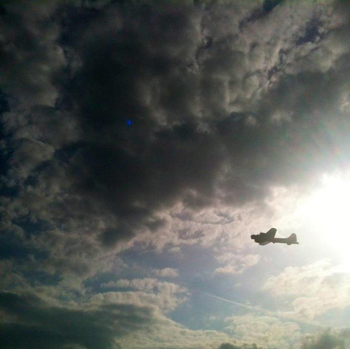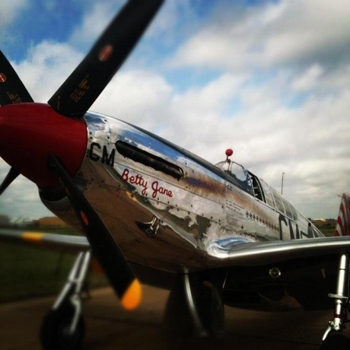The past few weeks I’ve written about photos my fellow professors have posted to me via Facebook. They’re all globetrotters, visiting battlefields the world over during the summer, and they love to lord it over a stay-at-home like me. And hell, I admit: I don’t mind. In fact, I love it.
Nowadays, however, it isn’t just your colleagues who send you photos that make you sit up and take notice. I am fortunate to have some amazing students at the University of North Texas. We have a well staffed military history program here, and it attracts very fine students. I have one current student whom I’ll call K. She sits in the front row, where all the good ones sit. She can throw down on World War II like nobody’s business, she knows her Panzer IVs from her Panzer Vs, and she can become Highly Offended when I make the occasional disparaging comment about the Desert Fox. She knows her Wehrmacht.
Yeah. I actually get paid to teach students like this. I do love my job.
As befits someone with her interests, K also studies the Second World War outside of the classroom. She has a gig working at the Frontiers of Flight Museum in Dallas, located at Love Field, or as I like to call it, the thinking man’s DFW. Recently, the museum played host to some beautiful visiting aircraft, a B-17 (nicknamed “Nine o Nine”), a B-24 (“Witchcraft”), and a P-51 (“Betty Jane”). Student K took some sweet photos of all of them while they were in town, and I post a couple of them here for your edification.
 In the past few weeks, I posted an Italian tank that was arguably too light for its mission, and a German gun that was arguably too heavy. What I found interesting about the images I’m sharing today was the synergy between them. Let’s look first at the “Nine o Nine.” The B-17 Flying Fortress was invented before the war. It represented a school of thought, as yet untested, called strategic bombing. Its foundational notions were that the bomber would “always get through,” that precision daylight bombing could destroy the enemy’s crucial industrial nodes, and that air power could force the foe to his knees in a very brief period, without the massed infantry assaults and the million-man casualties that were the inevitable result. It was a happy notion of wars won quickly and bloodlessly, and it captivated the U.S. public and the decision-making elite alike.
In the past few weeks, I posted an Italian tank that was arguably too light for its mission, and a German gun that was arguably too heavy. What I found interesting about the images I’m sharing today was the synergy between them. Let’s look first at the “Nine o Nine.” The B-17 Flying Fortress was invented before the war. It represented a school of thought, as yet untested, called strategic bombing. Its foundational notions were that the bomber would “always get through,” that precision daylight bombing could destroy the enemy’s crucial industrial nodes, and that air power could force the foe to his knees in a very brief period, without the massed infantry assaults and the million-man casualties that were the inevitable result. It was a happy notion of wars won quickly and bloodlessly, and it captivated the U.S. public and the decision-making elite alike.
Like a lot of prewar notions, this one failed spectacularly. The B-17, for all its heavy defensive armament guns and alleged invulnerability, proved highly vulnerable indeed in the skies over Western Europe in 1943. Once their short-ranged fighter escorts had to turn back (roughly at the German border), the bombers had to go it alone against the Luftwaffe and the flak, and the losses were usually horrific. Anyone who still thinks of the American bomber offensive over Europe as a clean “above it all” venture just isn’t reading the current literature. “Wild blue yonder”? Hardly. How about “nightmare”?
Imagine being a B-17 crew approaching the German border, and–quite literally–watching your fighter escorts peeling off for home. Then imagine looking ahead, and seeing a horde of Luftwaffe fighter aircraft waiting for you. Licking their chops. Maybe even smiling,
Willkommen. Welcome to Germany.
 And that’s where “Betty Jane,” our magnificent P-51, comes into play. Every student of the war knows the tortured story of this aircraft’s development. An American airframe that consistently puzzled its designers by underperforming. Engine problems. Low altitude. Short range. The bright idea of attaching a British Rolls-Royce Merlin engine changed everything. Suddenly, the Allies had a super-plane that had the range to accompany the bombers all the way into Germany, not to mention a fighter that could challenge the Luftwaffe to plane-to-plane dogfights and almost always win. Those skilled German aces who swept the skies free in 1940-41 suddenly looked all too mortal. It was the iron and unforgiving logic of 1944.
And that’s where “Betty Jane,” our magnificent P-51, comes into play. Every student of the war knows the tortured story of this aircraft’s development. An American airframe that consistently puzzled its designers by underperforming. Engine problems. Low altitude. Short range. The bright idea of attaching a British Rolls-Royce Merlin engine changed everything. Suddenly, the Allies had a super-plane that had the range to accompany the bombers all the way into Germany, not to mention a fighter that could challenge the Luftwaffe to plane-to-plane dogfights and almost always win. Those skilled German aces who swept the skies free in 1940-41 suddenly looked all too mortal. It was the iron and unforgiving logic of 1944.
And this, I think, is the point. It’s not just this or that weapon system. It’s the combination that counts. The B-17? An interesting and perhaps failed experiment. The P-51? A serendipitous, even random, outcome of coalition warfare; a stroke of luck that no one could have predicted. But you put these two aircraft together, the “Nine o Nine” and the “Betty Jane,” and what do you get?
You get victory.
Thanks, K. My students continue to teach me things. Like I say: I love my job.
For the latest in military history from World War II‘s sister publications visit HistoryNet.com.




